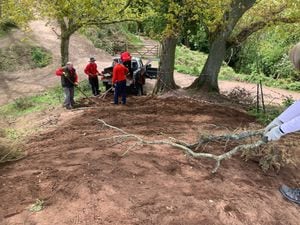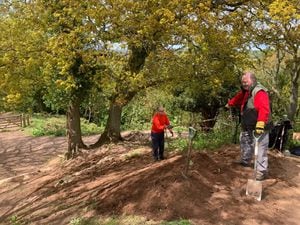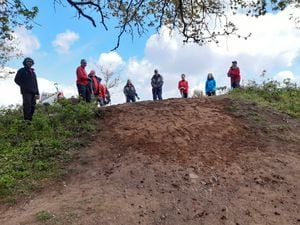Work underway to protect Iron Age monuments at Kinver Edge
An ancient Iron Age Hill Fort on Kinver Edge will be preserved for the future through vital works by a group of National Trust rangers and volunteers.

Kinver Hillfort is thought to date back to the late Bronze Age, with pieces of the fort visible to those visiting Kinver Edge.
But heavy rain and visitors trudging over the top of it has caused significant soil erosion and damage to the monument’s man-made ramparts.
To recreate the original profile of the fort, the team lifted and spread the contents of 800 soil-filled sandbags from the top of the steep ramparts.
Lead Ranger Ewan Chapman said: "It’s vitally important we do everything we can to protect this special archaeological feature.
"Kinver Edge is designated a Site of Special Scientific Interest which means we can’t bring soil in from elsewhere to repair the earthworks because it will disrupt the sensitive ecology of the area.
"Over the last couple of years, the Ranger team has been scraping soil at Kinver to create bare ground habitat for solitary bees, flies and wasps.
"Luckily, we’ve been able to re-use this soil for the Hillfort repairs.
"This is good news for Kinver’s special plants that rely on this type of local, low nutrient, soil to thrive."
The Hillfort was an important place and a strong fortress, part of a landscape of farmland and smaller settlements.
Two sides are formed by huge banks called ramparts, which would have probably had a wall or palisaded fence on the top.
The other two sides make use of the natural promontory to provide defence.

National Trust archaeology consultant Viviana Caroli said it was important to protect the hillfort as very few investigations had taken place.
She said: "A decade ago, a student carried out a geophysical survey combining resistivity and magnetometry, although the results did not shed more light on distribution and existence of any significant features.
"Faint marks of a couple of circular features were identified to the south-east corner of the interior of the fort and they were attributed to possible round houses or drip gullies associated to these buildings.
"However, this cannot be said for certain without further investigation through other techniques, including excavation and an updated geophysical survey."
Ms Caroli also spoke about what the hillfort had been used for over the years.
She said: "It is also important to say that the interior was subjected to agricultural activity in the Medieval/Post-Medieval period.

"This is important to mention for two reasons as it indicates continuity in use and ploughing might have had a significant impact on the survival or any pre-dating activity.
"The only surviving earthworks are faint traces of ridge and furrow running north-east to south-west, and also these are visible, if at all, in winter with snow."
With the work helping to fortify the natural fort and create a more solid foundation, Ms Caroli spoke about what could be done next to look at the history of the fort.
She said: "Further research and investigation should be allowed to gain a better understanding of the monument and the people who interacted with the environment.
"This would include investigations within the interior, but also outside the ramparts."
"The repair works carried out at Kinver Hillfort is part of our management agreement with Historic England.
"The management work we are currently doing is vital to ensure the monument will be preserved for the future and reduce loss."





